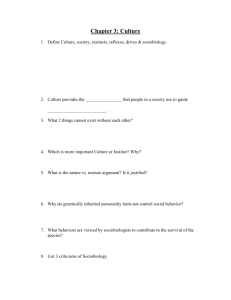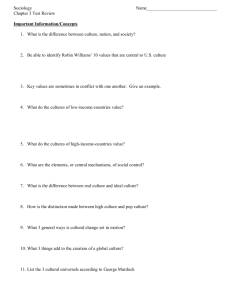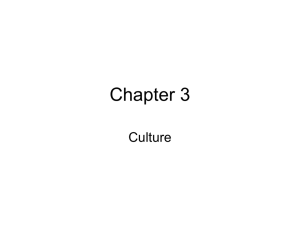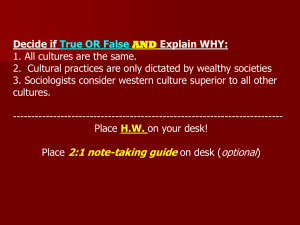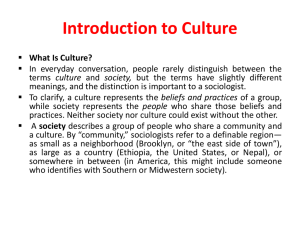Unit 1 notes student copy
advertisement
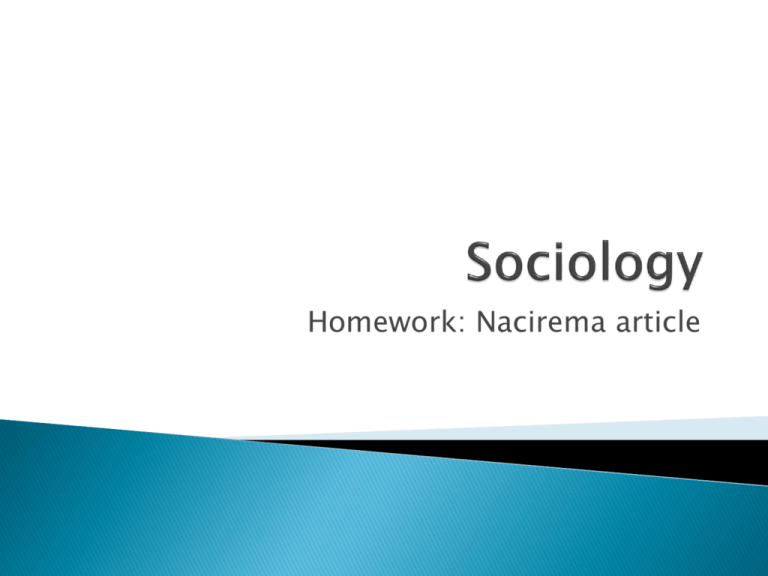
Homework: Nacirema article Social Science: Psychology Anthropology History Economics: Government/Political Science : ◦ Disciplines that study human social behavior or institutions and functions of human society in a scientific matter individual Biological and cultural development (compare past and present cultures) past production, distribution, and consumption of goods (financial) Laws. government system functions theories, purpose ◦ How would History, Anthropology, Psychology, Economics, and political science study Juvenile Delinquency? Sociology? Sociology The study of human society and social behavior ◦ Most interested in SOCIAL INTERACTIONS – how people relate to one another What groups are you a part of? ◦ Do you act differently in different groups? What ideas/characteristics do most of us as a society share? What varies? is there anything that ALL of us have in common? Page 1 in packet SP: being able to look beyond commonly held beliefs to the hidden meanings behind human actions ◦ Remember: through the lens of a sociologist the view always remains on the social, or group ◦ Why does a young man join a gang? Does not explain by looking at the individual – he is violent or a delinquent but explains by looking at the group influence Taught by society to be ‘masculine’ Protection in an unsafe environment ◦ Benefits to having SP? • Sociological Imagination: ability to range from the most impersonal and remote topics to the most intimate features of the human self and see relations between the two - C Wright Mills believes all sociologist and students must possess this ability Ability to see connection between the larger world and one’s personal life ◦ Look at picture page 5 How might a sociologist view the interconnection of this closed factory and homeless person? How do we learn about our past societies? Study of past human societies ◦ Finding material culture (example: artifacts and cultural landscapes) Prehistoric societies with no written records for historians to study ◦ Material culture is the only data to analyze Individually: complete page 2 of packet ◦ Part one: worksheet ◦ Part two: writing response Industrial Revolution – Europe ◦ Rapid social and political changes The Urban move ◦ Social changes (e.g., increase in crime) Culture: shared products of human groups ◦ Material Culture: Physical objects that people create and use Automobiles, books, buildings, clothing etc. ◦ Nonmaterial culture: abstract human creations Beliefs, family patterns, ideas, language, political systems, rules etc. Not the same thing! Society – group of interdependent people who have organized to share a common culture and unity ◦ Society = people ◦ Culture – material and nonmaterial products that people create 1. Technology- combination of objects and rules - Example – computer (material) plus knowledge of computer skills & internet Acceptable rules of internet Screwdriver 2. Symbols (anything that represents something else) Helps create culture and communicate Shared meaning attached to it Chinese culture: clap hands to express worry or disappointment, laugh “Ho-Ho to express anger, stick out tongue to show surprise (1938 research) North America: ‘thumbs up” and “A-OK” symbols are insults to certain other cultures: U.S. President Richard Nixon made the A-OK sign in Brazil not realizing he was offering a crude insult 3. Language – organization of written or spoken symbols into a standardized system ◦ Express ideas ◦ English – United States 4. Values – shared beliefs about what is good or bad, right or wrong, desirable or undesirable. ◦ Help determine character of people in group ◦ Determines material and nonmaterial culture Norms: shared rules of conduct that tell people how to act in specific situations ◦ Cover your mouth when you cough – do not murder ◦ Can vary – selective norms, demographic ◦ 1. Folkways: norms that describe socially acceptable behavior but do not have great moral significance attached to them Example: Do not chew with your mouth open (Does not endanger wellbeing or stability of society) -What are the social norms attached to riding elevators? -How quickly would we give up on these norms if they were challenged? Elevator norm 2. Mores: (pronounced MORE-ay) great significance attached to them/Endangers society’s well being and stability ◦ Example: Fraud/Murder Laws – written rules of conduct enacted and enforced by the government ◦ punishment for violating mores to protect social well-beings ◦ Can also enforce folkways – example? Parking Tickets When we break a folkway we may notice people’s reactions *Experiments *Improv everywhere mission: to break social norms and watch people’s reactions Food Court Musical Frozen Grand Central Time loop Complete page 7-8 in Packet Technology: Symbols: Values: Norms: Laws: ◦ List 5 (remember – objects) and for each list at least one rule attached to the objects ◦ Write or draw 5 symbols – explain what each symbolizes to us ◦ Create one new symbol: What do you think is important to have a symbol for in our society but we do not yet have? ◦ List 5 American values ◦ List 5 folkways for Americans ◦ List 5 folkways for high school students ◦ List 5 mores ◦ 3 laws you support ◦ 3 laws you do not support Taboo : a norm that society holds so strongly that violating it results in extreme disgust. The violator is often considered unfit to live in that society. ◦ Example: In some Muslim cultures, eating pork is taboo because the pig is considered unclean. American Taboo? Universal Taboo? ◦ Pedophilia, bestiality, cannibalism ◦ Incest (among father and daughter) ◦ Cannibalism ◦ Evidence to suggest there are even exception to those taboo’s and some sociologist claim there are no Universal Taboos If you took a trip to Tokyo and meet some friends who are Japanese and invite you to dinner at their house ◦ What would you expect ? Bring a small gift Take off shoes and put on slippers you are offered When offered the place of honor at the table decline a couple of times before accepting Sit on the floor – do not stretch out your legs (considered rude to point soles of your feet at someone) During meal lift bowl to chest close to your mouth – use chopsticks Slurping while eating soup or noodles is acceptable Never pour your own drink! Do not leave a mess When done place chopsticks on your plate and fold napkin neatly. Cultural Univerals: features common to all cultures ◦ Examples? ◦ George Murdock – examined hundreds of cultures to determine what they had in common ◦ Found 65 cultural universals: cooking, dancing, family, feasting, greetings, funeral ceremonies, gift giving, housing, language, medicine, music, religion, sports, etc. Ethnocentrism: viewing one’s own culture and group as superior ◦ Often people have negative reactions to cultural traits different than their own Cultural Relativism: Belief that cultures should be judged by their own standards rather than by applying the standards of another culture ◦ Open minded – put yourself in their shoes ◦ Helps us understand practices that seem strange/different Read Case Study Page 6 Writing Response 3 – Think About it 1 & 2 Subculture: group with its own unique values, norms, and behaviors that exists within a larger culture ◦ Do not reject all values and practices of larger society ◦ Example: Age, gender, ethnic, religious, political, social-class, occupations (teachers, police) Counterculture: rejects major values, norms, and practices of larger society and replaces them with a new set of cultural patterns ◦ challenge the values of the larger society ◦ Anarchists, organized crime, hippies Argot: a specialized vocabulary peculiar to a particular class or group of people Counterculture: rejects major values, norms, and practices of larger society and replaces them with a new set of cultural patterns ◦ challenge the values of the larger society ◦ Anarchists, organized crime, hippies Argot: a specialized vocabulary peculiar to a particular class or group of people The Arapesh and the Mundugumor ◦ Page 32 Read about the two societies ◦ Writing Response: 1. T-chart: compare the two societies Characteristics of society What things are important to them 2. What factors account for the differences among these two societies? In other words why aren’t we all the same?
